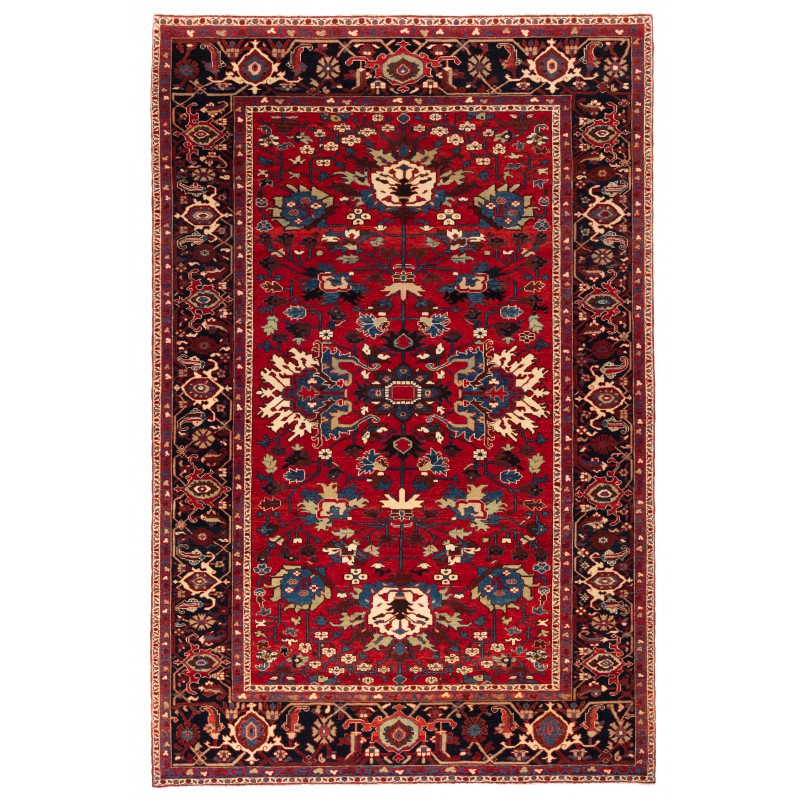
- Stock: 売り切れ
- Model: C31006
- サイズ: 280cm x 182cm
この絨毯は19世紀のもので、ガルス(ゲラスまたはガルス)地域、東部クルディスタン地域の中央メダリオンに連結されたパルメットと花がデザインされた絨毯です。ガルスはペルシャの平原に接する丘陵地帯に位置し、ガルスは古代から重要なクルド人の都市であり、メディア・マイナーの首都でした。ガルスの作家、科学者、政治家はサファヴィ朝に貢献し、それは主要な商業センターでした。ガルスは19世紀にはセンナよりも人口が多かったです。西部ペルシャに位置していたため、アフガンの蹂躙やナーディル・シャーの経済的な無能の影響をある程度逃れることができました。18世紀には、高い税金を徴収しようとする中央集権的なペルシャ政府の不在と、ザンド朝の良心的で分散した支配によって恩恵を受けました。ガルスの優れた織物学校は、エドワーズが提案したように、機械仕掛けの神からのものではなく、むしろ何世紀もの技術と伝統の産物でした。ガルスの織物は、数世紀にわたる地域の安定性から恩恵を受けました。これにより、芸術が発展し洗練されるための十分な時間がありました。さらに、これは経済が製品を支える豊かな州であり、西アジアの主要な商業街に近く、国際貿易から恩恵を受けることができました。タブリーズとその市場からはそれほど遠くありませんでした。1880年には、ヨーロッパとタブリーズの商人たちが、現在「ビジャル(ビジャール)」と呼ばれる有名な絨毯を織るためのガルスの工房を設立しました。これらの織物は、絨毯のコレクターによって長年にわたり愛され、保存されてきました。ガルスの染色工は硬い光沢のあるウールに豊かな色彩を施し、多花の模様で装飾されたものは、多くの人々にとって最も魅力的なクルド都市の織物とされています。この絨毯のデザインは、私たちのデザイナーによって解釈され、柔らかい色彩が使用されています。
This is a central medallion with connected palmette and flowers designed carpet 19th century from Garrus ( Gerous or Garus ) region, Eastern Kurdistan area. Garrus is located in the foothills approaching the flatlands of Persia, Garrus has been a significant Kurdish city since antiquity when it was the capital of Media Minor. Important writers, scientists, and politicians from Garrus contributed to the Safavid dynasty, and it was a major commercial center. Garrus was more populous than Senna in the nineteenth century. As it was in the west of Persia, it was fortunate to escape the ravages of the Afghans and to a certain extent the economic incompetence of Nadir Shah. In the eighteenth century, it benefited from the lack of a centralized Persian government bent on collecting high taxes, and from the benign, decentralized rule of the Zands. The brilliant weaving school of Garrus, like that of Senna, did not develop in a vacuum in a process of deus ex machina as Edwards proposed but rather was the product of centuries of skill and tradition. Garrus weaving benefited from the area’s stability over the centuries, which meant that there was enough time for the art to develop and become refined. Moreover, this was a rich province whose economy could support its products, and which was located sufficiently close to the major commercial arteries of western Asia to benefit from international commerce. It was not far from Tabriz and its markets. In 1880 European and Tabriz merchants developed workshops in Garrus for weaving the famed carpets that are called “Bijar (Bidjar)” today. These weavings have been treasured and preserved down the years by rug collectors. The rich colors applied by Garrus dyers to the lustrous hard wool in multi-flowered patterns are considered by many to be the most attractive of Kurdish urban weavings. This carpet’s design shows a vigorous central medallion; flowers, palmettes, and leaves in the field and ornamented with floral forms contrasting with the border. In the field, a rich assortment of decorative but naturalistic flowers, leaves, and palmettes. The design of the carpet is interpreted by our designers and soft colors are used for this carpet.
